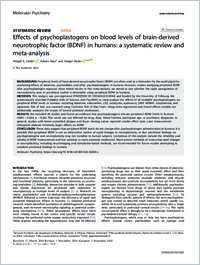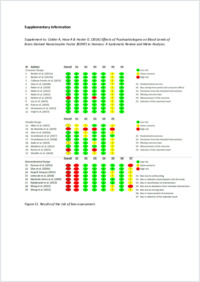Effects of psychoplastogens on blood levels of brain-derived neurotrophic factor (BDNF) in humans: a systematic review and meta-analysis
DOKPE
- Calder, Abigail E. ORCID University of Fribourg
- Hase, Adrian ORCID University of Fribourg
- Hasler, Gregor ORCID University of Fribourg
- 2024
Published in:
- Molecular Psychiatry. - London, UK: Springer Nature. - 2024, p. 1-14
English
Background: Peripheral levels of brain-derived neurotrophic factor (BDNF) are often used as a biomarker for the rapid plasticity-promoting effects of ketamine, psychedelics, and other psychoplastogens in humans. However, studies analyzing peripheral BDNF after psychoplastogen exposure show mixed results. In this meta-analysis, we aimed to test whether the rapid upregulation of neuroplasticity seen in preclinical studies is detectable using peripheral BDNF in humans.
Methods: This analysis was pre-registered (PROSPERO ID: CRD42022333096) and funded by the University of Fribourg. We systematically searched PubMed, Web of Science, and PsycINFO to meta-analyze the effects of all available psychoplastogens on peripheral BDNF levels in humans, including ketamine, esketamine, LSD, psilocybin, ayahuasca, DMT, MDMA, scopolamine, and rapastinel. Risk of bias was assessed using Cochrane Risk of Bias Tools. Using meta-regressions and mixed effects models, we additionally analyzed the impact of several potential moderators.
Results: We included 29 studies and found no evidence that psychoplastogens elevate peripheral BDNF levels in humans (SMD = 0.024, p = 0.64). This result was not affected by drug, dose, blood fraction, participant age, or psychiatric diagnoses. In general, studies with better-controlled designs and fewer missing values reported smaller effect sizes. Later measurement timepoints showed minimally larger effects on BDNF.
Conclusion: These data suggest that peripheral BDNF levels do not change after psychoplastogen administration in humans. It is possible that peripheral BDNF is not an informative marker of rapid changes in neuroplasticity, or that preclinical findings on psychoplastogens and neuroplasticity may not translate to human subjects. Limitations of this analysis include the reliability and validity of BDNF measurement and low variation in some potential moderators. More precise methods of measuring rapid changes in neuroplasticity, including neuroimaging and stimulation-based methods, are recommended for future studies attempting to translate preclinical findings to humans.
Methods: This analysis was pre-registered (PROSPERO ID: CRD42022333096) and funded by the University of Fribourg. We systematically searched PubMed, Web of Science, and PsycINFO to meta-analyze the effects of all available psychoplastogens on peripheral BDNF levels in humans, including ketamine, esketamine, LSD, psilocybin, ayahuasca, DMT, MDMA, scopolamine, and rapastinel. Risk of bias was assessed using Cochrane Risk of Bias Tools. Using meta-regressions and mixed effects models, we additionally analyzed the impact of several potential moderators.
Results: We included 29 studies and found no evidence that psychoplastogens elevate peripheral BDNF levels in humans (SMD = 0.024, p = 0.64). This result was not affected by drug, dose, blood fraction, participant age, or psychiatric diagnoses. In general, studies with better-controlled designs and fewer missing values reported smaller effect sizes. Later measurement timepoints showed minimally larger effects on BDNF.
Conclusion: These data suggest that peripheral BDNF levels do not change after psychoplastogen administration in humans. It is possible that peripheral BDNF is not an informative marker of rapid changes in neuroplasticity, or that preclinical findings on psychoplastogens and neuroplasticity may not translate to human subjects. Limitations of this analysis include the reliability and validity of BDNF measurement and low variation in some potential moderators. More precise methods of measuring rapid changes in neuroplasticity, including neuroimaging and stimulation-based methods, are recommended for future studies attempting to translate preclinical findings to humans.
- Faculty
- Faculté des sciences et de médecine
- Department
- Master en médecine
- Language
-
- English
- Classification
- Medicine
- License
- CC BY
- Open access status
- hybrid
- Identifiers
-
- DOI 10.1038/s41380-024-02830-z
- ISSN 1359-4184
- ISSN 1476-5578
- Persistent URL
- https://folia.unifr.ch/unifr/documents/330497
Other files
Statistics
Document views: 39
File downloads:
- s41380-024-02830-z.pdf: 80
- supplementaryinformation_meta-analysis_effectsofpsychoplastogensonperipheralbdnfinhumans.pdf: 40

